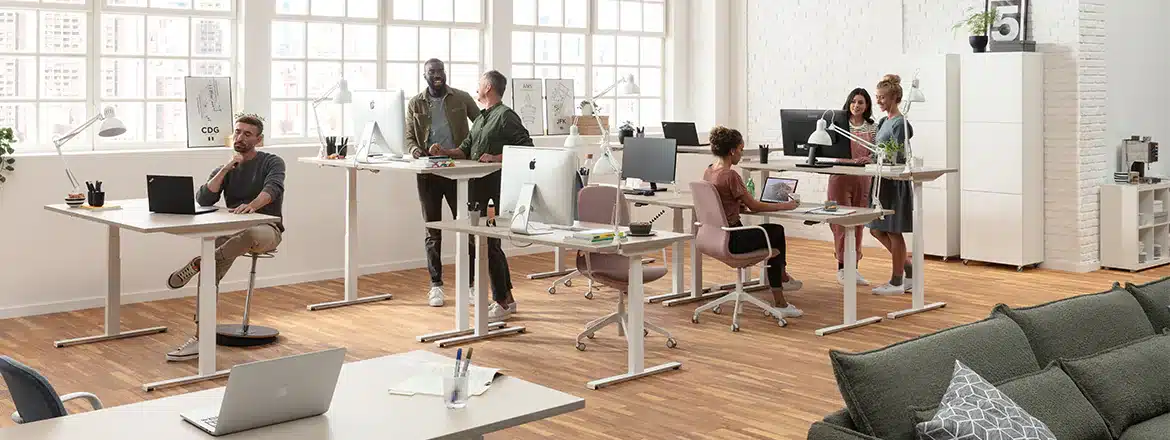The Rising Trend of Standing Desks in the Modern Workplace
In our dynamic and tech-powered world, where sitting for long hours is common and poses various health challenges, standing desks have emerged as a popular solution. These innovative constructions are designed to address health concerns associated with prolonged sitting and have gained global acceptance. Offering an alternative to the usual seated work environments, standing desks enable people to perform their daily activities on their feet. This article uncovers the intriguing aspects of a standing desk, highlighting its advantages, ergonomic features, and their increasing adoption in workplaces around the world.
What are the Health Advantages of Sit-Stand Desks?
Sit-stand desks are revolutionizing the way we approach our work environment, offering substantial benefits that extend beyond mere convenience. These dynamic workstations are not just about standing; they’re about introducing flexibility and movement into our daily routine. The health advantages of this ergonomic innovation are multifaceted, affecting both physical and mental wellness.
The impact of sit-stand desks extends to mental health and cognitive performance. The act of standing while working has been linked to enhanced mood and energy levels, contributing to reduced feelings of stress and depression.
Physical Health Benefits
A key advantage of using a standing desk in the office is the reduction of neck and back discomfort. Often, people slouch over their desks, causing stress on the neck, shoulders, and back, which can lead to pain and the need for medical care. A sit-stand desk encourages a healthier stance by allowing you to work while standing. This position helps maintain a straight spine and strengthens core muscles that support your upper body.
Additionally, sit-stand desks play a role in preventing Type 2 diabetes. A lifestyle with little movement can lead to excessive insulin production, increasing diabetes risk. This is especially true if you sit for long periods after eating. Standing after meals, made possible by sit-stand desks, helps maintain healthy blood sugar levels.
Using sit-stand desks may also lower obesity risk. Research indicates that fat-burning enzymes are less active when sitting, which can lead to fat accumulation and a slower metabolism. Standing while working, however, can burn additional calories each day, aiding in weight management.
Moreover, sit-stand desks can boost circulation. Sitting for long durations can hinder blood flow and cause tiredness. Standing, on the other hand, enhances heart function and blood circulation, benefiting both the body and mind.
Mental Health Benefits: Enjoy Your Daily Life Even More
Sit-stand desks can also boost mental health. Improved posture and circulation from standing can lead to increased alertness, motivation, and a positive outlook. With better posture and enhanced blood flow, you’re likely to feel more joyful, rejuvenated, and focused. This can lead to more efficient task completion and innovative problem-solving.
Additionally, standing desks can help overcome the common afternoon fatigue caused by prolonged sitting. Standing intermittently throughout the day can help you stay energized and refreshed.
Furthermore, these desks can improve concentration. By offsetting the sluggishness associated with long periods of sitting, increased blood circulation to the brain aids in clearer thinking and sustained focus.
Lastly, sit-stand desks can help lower stress levels. Improved circulation, posture, and metabolism collectively contribute to a healthier mindset and reduced anxiety. While a sedentary lifestyle can heighten the risk of anxiety and depression, alternating between sitting and standing during the day can mitigate these issues.
Many workplaces have recognized the advantages of standing desks and have enthusiastically adopted them. Leading companies like Google, Microsoft, and Facebook have integrated standing desks into their offices, investing in their employees’ health and productivity. This investment benefits both the staff and the organization.
This trend isn’t limited to big corporations. Small businesses and startups are also embracing standing desks. Many now offer employees the option to choose between standing and seated workstations, understanding that a healthier, more active workforce leads to greater productivity and lower healthcare costs.
The rise in remote work, especially since the global pandemic, has increased the popularity of standing desks. As people create home offices, the demand for ergonomic workstations has soared. Standing desk manufacturers have seen a significant boost in sales, meeting the needs of remote workers who seek to establish productive and healthy homework environments. Integrating standing desks into home offices is becoming a crucial part of remote working setups.
In this section, we tackle several widespread complaints and misconceptions about sit/stand desks.
A frequent grievance is the discomfort of standing for prolonged periods, resulting in pain in the calves and heels. It’s crucial to understand that sit/stand desks are not meant for standing continuously without breaks. Prolonged standing can transfer strain from the core and lower back to the legs and feet, causing muscle soreness and discomfort. To prevent this, alternating between sitting and standing during the day is recommended. This practice allows various body parts to rest, enhances blood circulation, and supports proper posture. For those experiencing foot pain, utilizing anti-fatigue mats can be beneficial in evenly distributing weight and reducing pressure on the feet.
Another issue raised is the perceived high cost of sit/stand desks. As a workaround, some might think of using boxes or books to prop up their laptops, seeing this as a way to save money. However, it’s important to emphasize that using makeshift, unstable materials not intended for this purpose can create safety hazards and increase the risk of workplace injuries. Investing in appropriate equipment and adhering to the manufacturer’s guidelines is strongly advised to ensure a safe and efficient work environment.
It’s also important to recognize that sit/stand desks themselves are not harmful to health. The real problem is the lack of movement. Stationary behaviors can lead to various health issues. By incorporating sit/stand desks and switching between sitting and standing, individuals can activate different muscle groups, which aids in preventing injuries and minimizes the chances of experiencing pain. Sit/stand desks should be seen as a tool to encourage regular movement throughout the day, rather than as a standalone solution.







